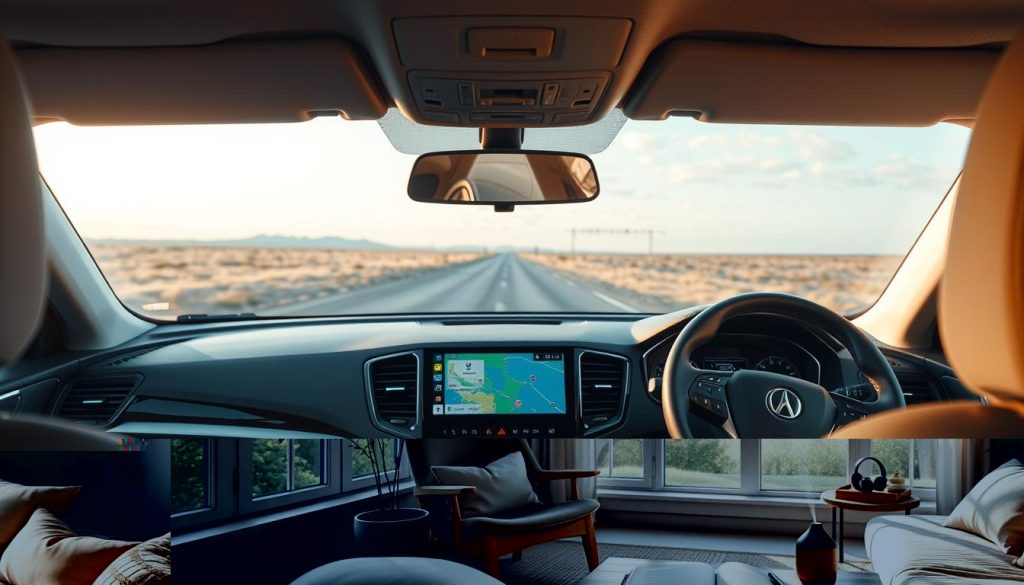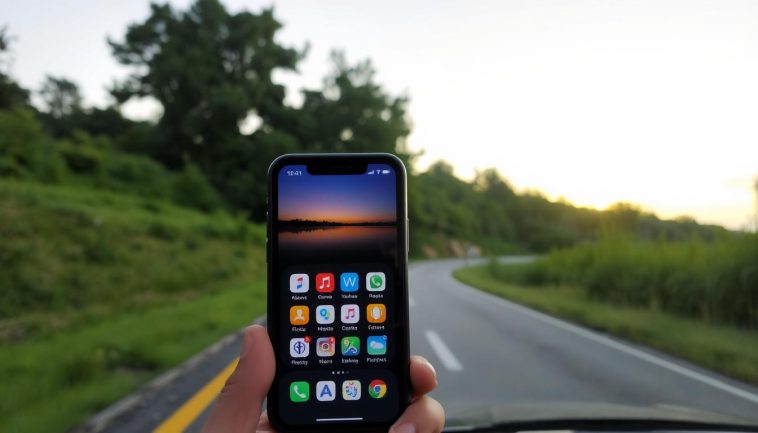anxietywhendriving.com highly recommends The Driving Fear Program to overcome your Driving Anxiety 90 Days Money Back Guarantee!
-->Click Here<--

A recent study found that 41% of drivers in the United States face driving anxiety or fear. This can include the stress of heavy traffic, parallel parking, or the fear of accidents. Luckily, there are many apps today that can help you feel more at ease while driving.
Key Takeaways
- Over 40% of U.S. drivers experience driving-related anxiety or fear
- Apps can help alleviate stress, panic, and other negative emotions while driving
- Discover a variety of “best apps for overcoming driving anxiety” to try
- Learn how “calm driving apps” and “mindful driving apps” can promote a relaxed state
- Explore “GPS apps for anxious drivers” and “panic attack prevention apps” for added support
Understanding Amaxophobia: The Fear of Driving
Amaxophobia is a fear of driving or being in a vehicle. It can cause a lot of anxiety and stress. It might be triggered by past accidents, heavy traffic, or feeling like you’re losing control.
It’s important to understand the symptoms and how amaxophobia affects people. This knowledge helps those who want to face and beat this fear.
Symptoms of Amaxophobia
The symptoms of amaxophobia can be physical and psychological. Physical signs include sweating, shaking, nausea, and a fast heartbeat. Psychological signs are intense anxiety, panic attacks, and a strong desire to avoid driving.
These symptoms can really get in the way of daily life. They make simple tasks like going to work or running errands hard.
Impact of Amaxophobia
Amaxophobia can affect many parts of your life. It can make it hard to keep a job because driving is often needed. It can also lead to social isolation, as you might not be able to go out or see friends and family.
This fear can also hurt your overall well-being. It can cause more stress, depression, and lower your quality of life.
Understanding amaxophobia and its effects is the first step to dealing with it. By knowing the challenges, we can support and help people overcome their driving anxiety. This way, they can feel free and independent again.
Best Apps for Overcoming Driving Anxiety
Many mobile apps now help people with driving anxiety. These driving fear apps offer tools to reduce stress and anxiety. They help drivers feel more calm and confident.
OFFTIME is one app that helps you stay focused while driving. It blocks distracting apps and notifications. This way, drivers can concentrate better and avoid anxiety.
Breathe2Relax is another great app. It teaches deep breathing to lower stress and anxiety. These techniques are very helpful in stressful driving situations.
- Google Maps gives real-time traffic updates and directions. This helps anxious drivers feel more in control.
- Apps like JustPark and Find My Car make finding parking easier. This can reduce stress for those with road anxiety.
Using these anxiety relief apps, calm driving apps, and GPS apps for anxious drivers can help. They help people overcome their driving fear and feel more confident on the road.
| App Name | Key Features | Benefits |
|---|---|---|
| OFFTIME | Digital detox, app blocking | Reduces distraction, promotes focus |
| Breathe2Relax | Guided breathing exercises | Decreases stress and anxiety |
| Google Maps | Real-time traffic updates, navigation | Improves driving confidence, reduces uncertainty |
| JustPark, Find My Car | Parking spot location and reservation | Reduces parking-related stress |
“These mindful driving apps and confident driver apps have been instrumental in helping me overcome my panic attacks when driving and regain my sense of control on the road.”
Cognitive-Behavioral Therapy (CBT) for Amaxophobia
For those with amaxophobia, or the fear of driving, CBT is a top choice. It helps change negative thoughts and beliefs that cause fear. This way, patients see things more clearly and rationally.
Identifying and Challenging Negative Thoughts
The first step in cognitive-behavioral therapy for fear of driving is to spot negative thoughts. Patients track their thoughts before, during, and after driving. Then, they learn to swap these thoughts for better, more realistic ones.
Gradual Exposure Therapy
Gradual exposure therapy is key in CBT for amaxophobia. It starts with small steps, like easy driving tasks. Then, it moves to harder ones. This way, patients face their fears in a safe place, learning to handle their anxiety.
By tackling negative thoughts and facing fears step by step, cognitive-behavioral therapy for amaxophobia is very effective. It helps people feel more independent, less stressed, and enjoy the freedom of driving without fear.

“CBT has been a game-changer for me. By learning to identify and challenge my negative thoughts about driving, I’ve been able to gradually overcome my fear and regain my confidence behind the wheel.”
The Power of Virtual Reality Exposure Therapy (VRET)
Virtual Reality Exposure Therapy (VRET) is a new way to treat amaxophobia, or the fear of driving. It lets people face their driving fears in a safe virtual world. This helps build confidence and strength.
VRET offers big benefits for those with amaxophobia. It uses virtual driving scenes to help patients face their fears step by step. This makes them less scared of driving and more willing to do it.
One big plus of VRET is it can be customized for each person. Therapists can adjust the virtual driving scenes to fit what each patient needs. This makes the therapy process easier and more effective.
| Benefits of VRET for Amaxophobia | Comparison to Traditional Exposure Therapy |
|---|---|
| Highly immersive and realistic virtual driving environments Personalized and controlled exposure to driving-related triggers Gradual and manageable desensitization process Improved sense of safety and control for patients | Greater control over exposure scenarios Ability to tailor therapy to individual needs Reduced risk of overwhelming or traumatizing patients Potential for faster and more effective results |
As virtual reality exposure therapy gets better, it’s becoming a key tool for treating amaxophobia and other fears. It uses technology to give patients a more real and helpful way to beat their fear of driving.
PsyTech VR: A Comprehensive Solution for Amaxophobia Treatment
Treating amaxophobia, or the fear of driving, is tough. But PsyTech VR brings a new, advanced way to tackle it. This virtual reality platform is designed to help with anxiety disorders, including amaxophobia.
Virtual Driving Environments and Scenarios
PsyTech VR focuses on virtual driving experiences. Users can try out different scenarios, like driving on highways or through busy cities. These safe, controlled settings help people face their fears and grow more confident.
The system keeps getting better with new VR therapy updates. This means users get the best treatments for their driving anxiety. With VR and proven therapies, PsyTech VR is a full solution for amaxophobia.
| PsyTech VR Features | Description |
|---|---|
| Virtual Driving Environments | Realistic simulations of various driving scenarios, from highways to city streets |
| Gradual Exposure Therapy | Stepwise approach to gradually increase exposure and build confidence |
| Customizable Experiences | Ability to personalize virtual environments and scenarios based on individual needs |
| Regular Updates | Continuous improvement and integration of the latest advancements in VR therapy |
With PsyTech VR, people with fear of driving can start a journey to beat their amaxophobia. They can regain their confidence while driving.
Comparing VRET and Imaginal Exposure Therapy (IET)
Both Virtual Reality Exposure Therapy (VRET) and Imaginal Exposure Therapy (IET) are good for treating anxiety. But, VRET might be better for fighting the fear of driving, or amaxophobia.
VRET lets people feel more real and face driving fears in a safe way. This makes therapy more effective. It helps people face their fears and feel more confident to drive.
VRET also makes therapy feel less scary. It’s private and easy to get to. This encourages more people to get help for their driving fears.
“VRET has shown it can help with many anxiety disorders, including driving fear. It offers a safe place to face fears.”
VRET is a strong choice for fighting driving fear. It’s more real, engaging, and helps reduce stigma. This makes it a great option for those afraid to drive.
Making VR Therapy Accessible and Affordable
Virtual reality (VR) therapy has become more affordable and accessible in recent years. This is great news for those looking for treatment for amaxophobia and other mental health issues. Several factors have led to these changes.
Advances in display and processing technology have made VR therapy more affordable. As technology improves, VR headsets have gotten cheaper. This has helped more people try VR therapy. Also, more companies entering the VR market have driven down prices.
The use of VR in different industries has also helped lower costs. As VR becomes more popular, it becomes cheaper. This makes VR therapy more available to those who need it.
“The decreased costs and increased accessibility of VR therapy have been a game-changer for individuals seeking treatment for driving anxiety and other mental health conditions. This technology has the potential to revolutionize the way we approach mental health care.”
VR therapy is now a more viable and affordable option for treating amaxophobia and other driving-related anxieties. As VR technology keeps improving, it will likely become even more accessible and affordable.
Mindfulness and Relaxation Apps for Driving Anxiety
Driving anxiety can be tough to handle. But, using mindfulness and relaxation can help a lot. There are many mindfulness apps for driving anxiety, relaxation apps for driving anxiety, and apps to reduce stress while driving out there. These tools can help you manage your anxiety better while driving.
Breathe2Relax is one such app. It guides you through breathing exercises to stay calm while driving. These mindfulness practices help you control your emotions and stay focused. This makes driving less stressful.
Calm and Headspace are other great options. They offer meditation and relaxation exercises for driving anxiety. These mindfulness apps for driving anxiety and relaxation apps for driving anxiety help you feel peaceful and in control. They help you face your fears and anxieties while driving.
Using these apps to reduce stress while driving can change your life if you have amaxophobia. They combine mindfulness and relaxation with strategies to beat driving anxiety. This way, you can feel more confident and enjoy driving again.
“Incorporating mindfulness and relaxation techniques into my driving routine has been a true lifesaver. I no longer dread getting behind the wheel, and I feel more in control of my anxiety.”
| App Name | Key Features | Pricing |
|---|---|---|
| Breathe2Relax | Guided breathing exercises Stress management tools Personalized tracking | Free |
| Calm | Meditation sessions Sleep stories Music and soundscapes | Free with in-app purchases |
| Headspace | Guided meditations Mindfulness exercises Sleep and focus content | Free with in-app purchases |
Navigation and Parking Apps for Stress-Free Driving
Driving anxiety can make navigating and parking tough. Luckily, many mobile apps are here to help. They make driving easier for those with amaxophobia.
Google Maps is a great app. It gives real-time traffic updates and directions. It also helps find and book parking spots ahead of time. This way, drivers can feel more in control and less stressed.
JustPark is another useful app. It lets users find and book parking spots before they get there. This is great for those with driving anxiety. It saves time and reduces stress.
There are also apps made just to help with driving anxiety. These apps offer guided meditations and relaxation exercises. They even give feedback on your body’s state while driving. This helps manage anxiety on the road.
Using these navigation apps for anxious drivers and parking apps for anxious drivers can make driving better. They help reduce stress and boost confidence.

“Using apps to help with navigation and parking has been a game-changer for me. I no longer have to worry about getting lost or finding a place to park, which has significantly reduced my driving-related stress and anxiety.”
Conclusion
In today’s world, many apps and new technologies help people deal with driving anxiety. These include cognitive-behavioral therapy, virtual reality therapy, and mindfulness. These tools help tackle the fear of driving.
Using these tools, people can feel more confident and manage their anxiety. They can regain the freedom and independence of driving. The right apps and strategies help overcome driving fears and enjoy driving.
VR therapy and mindfulness are just a few solutions in the digital world. They address the causes of driving fear. With these resources, drivers can start a journey to overcome their fear and feel excited about driving.
FAQ
What are the best apps for overcoming driving anxiety?
Apps like OFFTIME, Breathe2Relax, Google Maps, JustPark, and Find My Car can help. They offer features to reduce driving stress and anxiety. These include digital disconnection, breathing exercises, navigation, and parking assistance.
What is amaxophobia and what are its symptoms?
Amaxophobia is the fear of driving or being in a vehicle. Symptoms include physical signs like sweating, shaking, and nausea. They also include intense anxiety and avoiding driving.
How can cognitive-behavioral therapy (CBT) help with overcoming the fear of driving?
CBT helps by identifying and challenging negative thoughts and beliefs. It uses exposure therapy to gradually face fears in a safe way.
What is virtual reality exposure therapy (VRET) and how does it compare to imaginal exposure therapy (IET)?
VRET offers a highly immersive therapy experience. It lets people face their driving fears in a safe virtual space. Studies show VRET might be more effective than IET in some cases.
How does PsyTech VR help in the treatment of amaxophobia?
PsyTech VR uses virtual reality to treat anxiety disorders, including amaxophobia. It allows users to practice driving in various scenarios. This helps build confidence and resilience.
How have advancements in technology made VR therapy more accessible and affordable?
Better display and processing tech, more competition, and wider VR adoption have made headsets cheaper. This has made VR therapy more accessible for mental health conditions like amaxophobia.
How can mindfulness and relaxation apps help with driving anxiety?
Apps like Breathe2Relax offer guided breathing exercises. They help users stay calm and focused while driving. This makes driving less stressful and more manageable.
How can navigation and parking apps help reduce stress for drivers with anxiety?
Apps like Google Maps and JustPark provide real-time traffic updates and directions. They also help find and reserve parking spots. This makes drivers with amaxophobia feel more in control and less stressed.
anxietywhendriving.com highly recommends The Driving Fear Program to overcome your Driving Anxiety. 90 Days Money Back Guarantee!
-->Click Here<--



